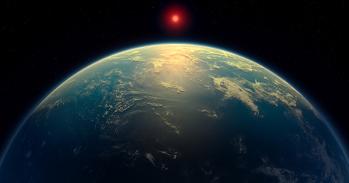
An international team of astronomers, led by the University of Cambridge, announced the most detailed ever catalogue of the stars in a huge swathe of our Milky Way galaxy.
An international team of astronomers, led by the University of Cambridge, announced the most detailed ever catalogue of the stars in a huge swathe of our Milky Way galaxy.
Gaia is measuring the distances of hundreds of millions of objects that are many thousands of light years away, at an accuracy equivalent to measuring the thickness of hair at a distance of more than 2000 kilometres
Floor van Leeuwen
The measurements of stellar positions, movement, brightness and colours are in the third early data release from the European Space Agency’s Gaia space observatory, and are now publicly available. Initial findings include the first optical measurement of the acceleration of the Solar system.
Launched in 2013, Gaia operates in an orbit around the so-called Lagrange 2 (L2) point, located 1.5 million kilometres behind the Earth in the direction away from the Sun. At L2 the gravitational forces between the Earth and Sun are balanced, so the spacecraft stays in stable position, allowing long-term essentially unobstructed views of the sky.
The primary objective of Gaia is to measure stellar distances using the parallax method. In this case astronomers use the observatory to continuously scan the sky, measuring the apparent change in the positions of stars over time, resulting from the Earth’s movement around the Sun.
Knowing that tiny shift in the positions of stars allows their distances to be calculated. On Earth this is made more difficult by the blurring of the Earth’s atmosphere, but in space the measurements are only limited by the optics of the telescope.
Two previous releases included the positions of 1.6 billion stars. Today’s release brings the total to just under 2 billion stars, whose positions are significantly more accurate than in the earlier data. Gaia also tracks the changing brightness and the positions of the stars over time across the line of sight (their so-called proper motion), and by splitting their light into spectra, measures how fast they are moving towards or away from the Sun and assesses their chemical composition.
The new data include exceptionally accurate measurements of the 300,000 stars within the closest 326 light years to the Sun. The researchers use these data to predict how the star background will change in the next 1.6 million years. They also confirm that the Solar system is accelerating in its orbit around the Galaxy.
This acceleration is gentle, and is what would be expected from a system in a circular orbit. Over a year the Sun accelerates towards the centre of the Galaxy by 7 mm per second, compared with its speed along its orbit of about 230 kilometres a second.
Gaia data additionally deconstruct the two largest companion galaxies to the Milky Way, the Small and Large Magellanic Clouds, allowing researchers to see their different stellar populations. A dramatic visualisation shows these subsets, and the bridge of stars between the two systems.
Dr Floor van Leeuwen of Cambridge’s Institute of Astronomy said: “Gaia is measuring the distances of hundreds of millions of objects that are many thousands of light years away, at an accuracy equivalent to measuring the thickness of hair at a distance of more than 2000 kilometres. These data are one of the backbones of astrophysics, allowing us to forensically analyse our stellar neighbourhood, and tackle crucial questions about the origin and future of our Galaxy.”
Gaia will continue gathering data until at least 2022, with a possible mission extension until 2025. The final data releases are expected to yield stellar positions 1.9 times as accurate as those released so far, and proper motions more than 7 times more accurate, in a catalogue of more than two billion objects.
“The mysteries of the Milky Way and our Solar System have captured the imagination of generations of scientists and astronomers across the world – all eager to learn more about the origins of the Universe,” said Science Minister Amanda Solloway. “Through this remarkable government-backed mission, UK scientists have taken us a giant leap closer to advancing our knowledge of how our Solar System began by painting the most detailed picture yet that could help to redefine astronomy as we know it.”
Adapted from a Royal Astronomical Society press release.

The text in this work is licensed under a Creative Commons Attribution 4.0 International License. Images, including our videos, are Copyright ©University of Cambridge and licensors/contributors as identified. All rights reserved. We make our image and video content available in a number of ways – as here, on our main website under its Terms and conditions, and on a range of channels including social media that permit your use and sharing of our content under their respective Terms.




